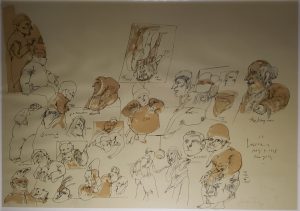(Click to Enlarge)
History of Crime
Jose Luis Cuevas
1968
Dimensions sheet: 22 x 30 in. (55.9 x 76.2 cm)
Mediums Description: color lithograph
Signed in graphite lower right, “Cuevas” and “XVII – XXV” lower left
Jose Luis Cuevas (1934 – 2017)
Starting in the late 1950s, a group of artists throughout Latin American focused almost exclusively on figurative drawing and printmaking, or at the very least gave drawing in and of itself primacy within their production. José Luis Cuevas of Mexico became through his work, exhibitions, and polemical engagement, the best-known representative of this trend. In 1973 curator José Gómez Sicre commemorated Picasso’s recent death with an homage exhibition at OAS headquarters. Cuevas created this drawing on three sheets of paper exclusively for this occasion. He takes as point of departure the important pre-cubist work of 1907 Les Demoiselles D ’Avignon. The Mexican draftsman subverts the cubistic fragmentation of the original by drawing organic and expressionistic lines, which range from the subtle and delicate to the harsh and blunt. The “real ladies” are a group of worn-out sex workers and procuresses walking around a sordid brothel. In the two smaller drawings Cuevas includes himself among the sex workers; in one he is drawing them under the light of a bleak and solitary light bulb, and in the other his portrait is entrapped in a frame held by a nude and wrinkled sex worker with her legs open. This homage to Picasso is charged with paradox: Cuevas recognizes the centrality of the Spaniard’s work in modern art, while dismantling the formal and symbolic structure of the original into an image of alienation and sexual revulsion. José Luis Cuevas was born in Mexico. A sickly child, he suffered from rheumatic fever. In 1942 at age 11 he began attending La Esmeralda, Escuela Nacional de Pintura, Escultura y Grabado and went on to study printmaking with Lola Cueto at Mexico City College. Cuevas focused on drawing and printmaking, rejecting painting as hollow and rhetorical. He rejected Mexican mural painting as falsely heroic, preferring the engravings of Posada and Orozco with their sordid subjects of sex work and urban poverty. In 1953 he had his first solo exhibition at the Galería Prisse in Mexico City, after which painter Felipe Orlando introduced his work to curator José Gómez Sicre of the Pan American Union. The following year Cuevas exhibited his drawings at the Pan American Union gallery; many entered prestigious collections of the Museum of Modern Art in New York, the Brooklyn Museum, and the Cleveland Art Institute. The First Prize in Drawing at the Fifth São Paulo Biennial followed. Cuevas cultivated publicity and promoted his image as an “enfant terrible” through interviews and articles that attacked both the muralists and the formalism of easel painters such as Tamayo. In 1965 he published his bilingual autobiography, Cuevas por Cuevas, which was ghostwritten by Gómez Sicre. In 1981 he received the National Prize of Fine Arts given by the Mexican government. In 1992 the Museo José Luis Cuevas, located in the restored Convent of Santa Inés in the Centro Historico section of the Mexico City opened to the public.
Selected Collections:
Museum of Modern Art (MOMA)
Smithsonian American Art Museum
José Luis Cuevas Museum




